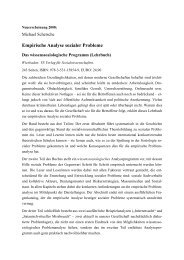Psychophysiology of False Memories in a Deese-Roediger ... - IGPP
Psychophysiology of False Memories in a Deese-Roediger ... - IGPP
Psychophysiology of False Memories in a Deese-Roediger ... - IGPP
Create successful ePaper yourself
Turn your PDF publications into a flip-book with our unique Google optimized e-Paper software.
<strong>Psychophysiology</strong> <strong>of</strong> <strong>False</strong> <strong>Memories</strong> <strong>in</strong> a<br />
<strong>Deese</strong>-<strong>Roediger</strong>-McDermott Paradigm with Visual Scenes<br />
Ali Baioui 1 *, Wolfgang Ambach 2 , Bertram Walter 1 , Dieter Vaitl 1,2<br />
1 Bender Institute <strong>of</strong> Neuroimag<strong>in</strong>g, University <strong>of</strong> Giessen, Giessen, Germany, 2 Institute for Frontier Areas <strong>of</strong> Psychology and Mental Health, Freiburg, Germany<br />
Abstract<br />
Remember<strong>in</strong>g someth<strong>in</strong>g that has not <strong>in</strong> fact been experienced is commonly referred to as false memory. The <strong>Deese</strong>-<br />
<strong>Roediger</strong>-McDermott (DRM) paradigm is a well-elaborated approach to this phenomenon. This study attempts to<br />
<strong>in</strong>vestigate the peripheral physiology <strong>of</strong> false memories <strong>in</strong>duced <strong>in</strong> a visual DRM paradigm. The ma<strong>in</strong> research question is<br />
whether false recognition is different from true recognition <strong>in</strong> terms <strong>of</strong> accompany<strong>in</strong>g physiological responses. Sixty<br />
subjects participated <strong>in</strong> the experiment, which <strong>in</strong>cluded a study phase with visual scenes each show<strong>in</strong>g a group <strong>of</strong><br />
<strong>in</strong>terrelated items <strong>in</strong> social contexts. Subjects were divided <strong>in</strong>to an experimental group undergo<strong>in</strong>g a classical DRM design<br />
and a control group without DRM manipulation. The control group was implemented <strong>in</strong> order to statistically control for<br />
possible biases produced by memorability differences between stimulus types. After a short retention <strong>in</strong>terval, a pictorial<br />
recognition phase was conducted <strong>in</strong> the manner <strong>of</strong> a Concealed Information Test. Simultaneous record<strong>in</strong>gs <strong>of</strong> electrodermal<br />
activity, respiration l<strong>in</strong>e length, phasic heart rate, and f<strong>in</strong>ger pulse waveform length were used. Results yielded a significant<br />
Group by Item Type <strong>in</strong>teraction, show<strong>in</strong>g that true recognition is accompanied by greater electrodermal activity than false<br />
recognition. Results are discussed <strong>in</strong> the light <strong>of</strong> Sokolov’s Orient<strong>in</strong>g Reflex, the Prelim<strong>in</strong>ary Process Theory and the<br />
Concealed Information Test. Implications and restrictions <strong>of</strong> the <strong>in</strong>troduced design features are critically discussed. This<br />
study demonstrates the applicability <strong>of</strong> measures <strong>of</strong> peripheral physiology to the field <strong>of</strong> false memory research.<br />
Citation: Baioui A, Ambach W, Walter B, Vaitl D (2012) <strong>Psychophysiology</strong> <strong>of</strong> <strong>False</strong> <strong>Memories</strong> <strong>in</strong> a <strong>Deese</strong>-<strong>Roediger</strong>-McDermott Paradigm with Visual Scenes. PLoS<br />
ONE 7(1): e30416. doi:10.1371/journal.pone.0030416<br />
Editor: Claude Ala<strong>in</strong>, Baycrest Hospital, Canada<br />
Received July 19, 2011; Accepted December 15, 2011; Published January 17, 2012<br />
Copyright: ß 2012 Baioui et al. This is an open-access article distributed under the terms <strong>of</strong> the Creative Commons Attribution License, which permits<br />
unrestricted use, distribution, and reproduction <strong>in</strong> any medium, provided the orig<strong>in</strong>al author and source are credited.<br />
Fund<strong>in</strong>g: This study was solely f<strong>in</strong>anced by the Institute for Frontier Areas <strong>of</strong> Psychology and Mental Health (Freiburg, Germany) where the study was conducted.<br />
No additional grants or fund<strong>in</strong>g were <strong>in</strong>volved. The funders had no role <strong>in</strong> study design, data collection and analysis, decision to publish, or preparation <strong>of</strong> the<br />
manuscript.<br />
Compet<strong>in</strong>g Interests: The authors have declared that no compet<strong>in</strong>g <strong>in</strong>terests exist.<br />
* E-mail: Ali.A.Baioui@psychol.uni-giessen.de<br />
Introduction<br />
Schematic knowledge assists <strong>in</strong> the <strong>in</strong>tegration <strong>of</strong> new and old<br />
<strong>in</strong>formation, yet it also leads to a vulnerability for false memories<br />
(i.e., mistak<strong>in</strong>g new <strong>in</strong>formation as previously known). The<br />
authenticity <strong>of</strong> statements has been the focus <strong>of</strong> research on the<br />
detection <strong>of</strong> concealed <strong>in</strong>formation. Peripheral psychophysiological<br />
measures have been used to <strong>in</strong>vestigate whether statements are<br />
truthful or deceptive.<br />
The ma<strong>in</strong> idea <strong>of</strong> this study was to differentiate true from false<br />
memories, similar to the differentiation <strong>of</strong> true and false statements<br />
from a psychophysiological detection-<strong>of</strong>-<strong>in</strong>formation perspective<br />
(see [1]). Hence, the ma<strong>in</strong> start<strong>in</strong>g-po<strong>in</strong>t for differentiat<strong>in</strong>g true<br />
from false memories is the absence (false memory) or presence<br />
(true memory) <strong>of</strong> objective knowledge about an object.<br />
<strong>False</strong> memories <strong>in</strong> the DRM paradigm<br />
In the <strong>Deese</strong>-<strong>Roediger</strong>-McDermott (DRM) paradigm [2], subjects<br />
learn lists <strong>of</strong> closely related words (studied items; e.g. ‘‘bed’’,<br />
‘‘pillow’’, ‘‘sheet’’) <strong>in</strong> a study phase. Later, <strong>in</strong> a recognition phase,<br />
subjects <strong>of</strong>ten falsely recognize words (related lures; e.g. ‘‘sleep’’),<br />
which were not part <strong>of</strong> the previously learned lists but are strongly<br />
associated with these words. The external validity <strong>of</strong> the DRM<br />
paradigm was underl<strong>in</strong>ed by Clancy et al. [3]. They showed that<br />
susceptibility to false memories as evoked <strong>in</strong> DRM studies might<br />
be a feasible marker for proneness to false memories. In their<br />
study, people who reported to have memories <strong>of</strong> extremely<br />
improbable events (abduction by space aliens) showed higher false<br />
memory rates <strong>in</strong> a DRM experiment than controls. For an<br />
extensive review <strong>of</strong> the DRM paradigm and its applications, see<br />
[4].<br />
While the bulk <strong>of</strong> DRM studies was conducted with words as<br />
stimuli, some researchers used serially presented pictures [5–8]. In<br />
these studies, the use <strong>of</strong> pictures led to relatively low false memory<br />
rates. Instead <strong>of</strong> a serial presentation <strong>of</strong> pictorial stimuli, Miller<br />
and Gazzaniga [9] showed all items <strong>of</strong> a category simultaneously<br />
by us<strong>in</strong>g visual scenes <strong>in</strong> one <strong>of</strong> their experimental conditions<br />
(picture condition). This led to robust false memory rates. Miller<br />
and Gazzaniga’s [9] design has been successfully implemented <strong>in</strong><br />
two cl<strong>in</strong>ical studies [10,11]. In the healthy control groups <strong>of</strong> these<br />
studies (<strong>in</strong>vestigat<strong>in</strong>g posttraumatic stress disorder and schizophrenia<br />
patients as cl<strong>in</strong>ical groups), Miller and Gazzaniga’s f<strong>in</strong>d<strong>in</strong>gs<br />
could be replicated. With a scenic presentation <strong>of</strong> stimuli some<br />
methodological problems <strong>of</strong> the orig<strong>in</strong>al DRM design could be<br />
bypassed (e.g. primacy and recency effects <strong>in</strong> the study phase; see<br />
[2]: Experiment 1). Furthermore, pictorial stimuli might <strong>of</strong>fer a<br />
higher ecological validity and a broader base for generalizations.<br />
An <strong>in</strong>herent problem <strong>of</strong> the classical DRM design is the preselection<br />
<strong>of</strong> items serv<strong>in</strong>g as related lures. Stimuli are not randomly<br />
assigned to serve as related lures or studied items, respectively.<br />
This can lead to a priori differences <strong>in</strong> memorability <strong>of</strong> related<br />
lures and studied items [12]. Nessler et al. [13] argued that this<br />
PLoS ONE | www.plosone.org 1 January 2012 | Volume 7 | Issue 1 | e30416
<strong>Psychophysiology</strong> <strong>of</strong> Visual <strong>False</strong> <strong>Memories</strong><br />
could hamper studies <strong>in</strong>vestigat<strong>in</strong>g the psychophysiological<br />
<strong>in</strong>dicants <strong>of</strong> false memories (e.g. event-related potentials). As a<br />
consequence, they suggested the selection <strong>of</strong> lures from a<br />
categorically associated list <strong>of</strong> items (‘‘categorical design’’; e.g.<br />
[8,14,13]). Disadvantage <strong>of</strong> this design are smaller false recognition<br />
rates [13]. Thus, <strong>in</strong> DRM studies with visual stimuli, <strong>in</strong> which<br />
false recognition rates are lower than <strong>in</strong> studies with textual<br />
stimuli, the implementation <strong>of</strong> a categorical design seems<br />
impracticable. Obviously, the applicability <strong>of</strong> a categorical design<br />
strongly depends on the nature <strong>of</strong> the stimuli.<br />
We argue that this problem <strong>of</strong> the classical DRM design could<br />
also be approached by <strong>in</strong>clud<strong>in</strong>g a control group. In the control<br />
group, the subjects would actually view the related lures that are<br />
not shown <strong>in</strong> the experimental group. This permits the<br />
computation <strong>of</strong> between-group <strong>in</strong>teraction effects that address<br />
such a memorability bias statistically. To our knowledge, this has<br />
not been implemented before <strong>in</strong> a DRM study.<br />
Psychophysiological differentiation <strong>of</strong> true and false<br />
memories<br />
Several DRM studies exam<strong>in</strong>ed the neurophysiological correlates<br />
<strong>of</strong> false memories and outl<strong>in</strong>ed the differential reactions<br />
accompany<strong>in</strong>g true and false recognition us<strong>in</strong>g electroencephalography<br />
(e.g. [15–17,13]), functional magnetic resonance imag<strong>in</strong>g<br />
(e.g. [18–23]), and positron emission tomography [24]. For a<br />
review, see [25].<br />
To our knowledge, measures <strong>of</strong> peripheral physiology have not<br />
yet been applied <strong>in</strong> a DRM study. Such an endeavor could<br />
however be promis<strong>in</strong>g: especially EDA is well suited to reflect<br />
whether a stimulus is known or unknown to a subject; this has<br />
been shown for pictorial as well as for verbal material (e.g. [26])<br />
and also for semantically associated stimuli [27].<br />
Peripheral psychophysiology <strong>of</strong> object recognition<br />
In general, autonomic measures reflect basal processes such as<br />
the orient<strong>in</strong>g reflex [28], which is modulated by stimulus <strong>in</strong>tensity,<br />
significance, and novelty [29]. The orient<strong>in</strong>g reflex illustrates the<br />
relationship between <strong>in</strong>formation process<strong>in</strong>g and peripheral<br />
psychophysiology. Habituation processes lead to smaller response<br />
amplitudes <strong>in</strong> peripheral physiological measures if a stimulus is<br />
presented repeatedly [29]. Any change <strong>of</strong> this stimulus (<strong>in</strong> terms <strong>of</strong><br />
‘‘novelty’’ or ‘‘<strong>in</strong>tensity’’) evokes an orient<strong>in</strong>g response associated<br />
with an <strong>in</strong>creased response amplitude [29]. Likewise, any stimulus<br />
with a signal value evokes an enhanced orient<strong>in</strong>g response<br />
(significance; [30–33]). Sokolov [33] described that significance<br />
can be <strong>in</strong>duced through classical condition<strong>in</strong>g. Maltzman [32]<br />
expla<strong>in</strong>ed such an acquisition <strong>of</strong> stimulus significance by means <strong>of</strong><br />
cortical sets. Cortical sets are ‘‘additional focused cortical activity<br />
elicited via condition<strong>in</strong>g, <strong>in</strong>structions, or prior experience’’ [34].<br />
An activated cortical set can be <strong>in</strong>terpreted as an unconditioned<br />
stimulus, the perceived stimulus as neutral/conditioned stimulus,<br />
and significance as conditioned response [32].<br />
Bernste<strong>in</strong> et al. [35] conducted extensive research on the<br />
differential reactions <strong>of</strong> the different markers <strong>of</strong> peripheral<br />
physiology elicited by significance. They showed that time courses<br />
<strong>of</strong> electrodermal, cardiac, and eyebl<strong>in</strong>k responses diverge. These<br />
authors also po<strong>in</strong>ted out possible sequential processes that might<br />
be related to the orient<strong>in</strong>g reflex.<br />
Barry <strong>in</strong>tegrated parts <strong>of</strong> Sokolov’s, Maltzman’s, Bernste<strong>in</strong>’s and<br />
others’ f<strong>in</strong>d<strong>in</strong>gs about the orient<strong>in</strong>g reflex <strong>in</strong>to the Prelim<strong>in</strong>ary Process<br />
Theory (for a review <strong>of</strong> its development see [34]). This theory<br />
associates responses <strong>of</strong> the different peripheral measures with<br />
different stages <strong>of</strong> <strong>in</strong>formation process<strong>in</strong>g. The first stage <strong>of</strong><br />
<strong>in</strong>formation process<strong>in</strong>g, stimulus registration, is modulated by vigilance<br />
(an ‘‘attentive preparatory state’’) and is associated with cardiac<br />
deceleration (and ‘‘cephalic vasodilation’’). The next stage<br />
comprises magnitude registration (associated with peripheral vasoconstriction)<br />
and novelty registration (associated with respiratory pause).<br />
The actual mechanisms <strong>of</strong> the orient<strong>in</strong>g reflex, which depend on<br />
novelty, <strong>in</strong>tensity, and significance <strong>of</strong> the stimulus, present the last<br />
stage, which is directly l<strong>in</strong>ked to phasic sk<strong>in</strong> conductance<br />
responses. The <strong>in</strong>teraction between the partial mechanisms <strong>of</strong><br />
the orient<strong>in</strong>g reflex is still under discussion [34]. In the Prelim<strong>in</strong>ary<br />
Process Theory, all stages are framed by the modulatory <strong>in</strong>fluence<br />
<strong>of</strong> cortical sets. Cognitive, perceptual and motor processes (associated with<br />
cardiac acceleration) are the output <strong>of</strong> this <strong>in</strong>formation process<strong>in</strong>g<br />
model. The Prelim<strong>in</strong>ary Process Theory is ma<strong>in</strong>ly based on<br />
empirical data from the peripheral nervous system; it describes<br />
rather basic processes that are assumed to precede cognitive<br />
functions.<br />
We argue that these features render the Prelim<strong>in</strong>ary Process<br />
Theory a suitable framework for understand<strong>in</strong>g why and how<br />
physiological responses are an important marker for differentiat<strong>in</strong>g<br />
true from false memories.<br />
To summarize, a stimulus that a person has already encountered<br />
bears higher significance than a completely unknown stimulus.<br />
Accord<strong>in</strong>g to the Prelim<strong>in</strong>ary Process Theory, this difference <strong>in</strong><br />
significance should most directly be reflected <strong>in</strong> differences <strong>in</strong> phasic<br />
electrodermal responses to the presentation <strong>of</strong> the stimulus. We<br />
therefore hypothesize that stimuli that have been falsely recognized<br />
bear less significance than comparable correctly recognized stimuli.<br />
This difference <strong>in</strong> significance should be reflected <strong>in</strong> smaller<br />
electrodermal responses for falsely as compared to truly recognized<br />
stimuli.<br />
The <strong>in</strong>fluence <strong>of</strong> stimulus significance and novelty on physiological<br />
responses were <strong>in</strong>vestigated systematically <strong>in</strong> the context <strong>of</strong><br />
an <strong>in</strong>formation detection paradigm (e.g. [36–42]), the Concealed<br />
Information Test (CIT; formerly called Guilty Knowledge Test;<br />
[43]).<br />
The CIT is a systematic and standardized test procedure<br />
compar<strong>in</strong>g the physiological responses <strong>of</strong> a subject towards a<br />
number <strong>of</strong> crime-relevant yes-or-no questions (e.g. ‘‘Have you seen<br />
this object?’’). Physiological data usually comprise channels such as<br />
electrodermal activity, electrocardiogram, breath<strong>in</strong>g activity, and<br />
f<strong>in</strong>ger plethysmogram. Each crime-relevant question is comb<strong>in</strong>ed<br />
with the presentation <strong>of</strong> one previously encountered ‘‘probe’’ item<br />
and a number <strong>of</strong> ‘‘irrelevant’’ items. ‘‘Irrelevant’’ items are<br />
categorically related to the ‘‘probe’’ item but unknown to the<br />
subject. For theory and application <strong>of</strong> the CIT, see [1,42].<br />
In a CIT study, responses to known objects (probe items) are<br />
compared with responses to unknown objects (irrelevant items). A<br />
typical response pattern shows greater electrodermal activity<br />
(EDA), lower respiration l<strong>in</strong>e length, lower phasic heart rate,<br />
and lower f<strong>in</strong>ger pulse waveform length [44,1,45–47,41] for<br />
known objects. This effect is commonly attributed to stimulus<br />
significance [1].<br />
In general, CIT studies show that a subject’s knowledge about<br />
an item <strong>in</strong>fluences his/her psychophysiological responses when<br />
confronted with it a second time. CIT studies have been<br />
successfully conducted with a variety <strong>of</strong> stimuli, such as words,<br />
pictures, cards, and pictures <strong>of</strong> faces (for a review see [1]).<br />
The idea <strong>of</strong> exam<strong>in</strong><strong>in</strong>g false memories by means <strong>of</strong> peripheral<br />
physiological measures with application <strong>of</strong> CIT methodology has<br />
already been <strong>in</strong>vestigated <strong>in</strong> a doctoral thesis by Amato-<br />
Henderson [48], which used the mislead<strong>in</strong>g <strong>in</strong>formation paradigm<br />
[49,50]. The author reported that misled subjects had a higher<br />
probability <strong>of</strong> be<strong>in</strong>g categorized as truthful. Dockree et al. [51]<br />
used the mislead<strong>in</strong>g <strong>in</strong>formation paradigm to elicit false recall <strong>in</strong><br />
PLoS ONE | www.plosone.org 2 January 2012 | Volume 7 | Issue 1 | e30416
<strong>Psychophysiology</strong> <strong>of</strong> Visual <strong>False</strong> <strong>Memories</strong><br />
patients with traumatic bra<strong>in</strong> <strong>in</strong>jury and healthy controls. EDA<br />
responses were recorded dur<strong>in</strong>g recall. Results for the healthy<br />
control group <strong>in</strong>dicated a relationship between EDA responses<br />
and uncerta<strong>in</strong>ty dur<strong>in</strong>g recall. Allen and Mertens [15] comb<strong>in</strong>ed<br />
the DRM paradigm with an event-related potentials-based CIT;<br />
they found ‘‘little evidence that bra<strong>in</strong> electrical activity could<br />
differentiate true from false memories’’.<br />
Aims <strong>of</strong> the present study<br />
The present study was designed to explore whether responses <strong>in</strong><br />
peripheral psychophysiology differ between true and false<br />
memories. This was implemented by comb<strong>in</strong><strong>in</strong>g a DRM paradigm<br />
with electrodermal, cardiovascular, and respiratory measurement.<br />
Operationalization and data reduction were performed accord<strong>in</strong>g<br />
to CIT standards. We hypothesized that response differences<br />
between false and true recognition would be observable,<br />
analogously to the response differences to irrelevant (unknown)<br />
vs. probe (known) items <strong>in</strong> the CIT. Therefore, we expected false<br />
memories to elicit lower EDA, higher respiration l<strong>in</strong>e length,<br />
higher phasic heart rate, and higher f<strong>in</strong>ger pulse waveform length<br />
than true recognition.<br />
Further aims, as methodological advances over Miller and<br />
Gazzaniga’s [9] study design, were the <strong>in</strong>troduction <strong>of</strong> a control<br />
group, the <strong>in</strong>troduction <strong>of</strong> unrelated items, and the use <strong>of</strong> equal<br />
modalities (i.e. pictures only) <strong>in</strong> study and recognition phase.<br />
We argue that the <strong>in</strong>troduction <strong>of</strong> a control group is crucial for a<br />
false memory study us<strong>in</strong>g psychophysiological measures and a<br />
‘‘classical’’ DRM design. Between-group <strong>in</strong>teraction analyses were<br />
planned to control for possible a priori memorability differences<br />
between related lures and studied items. Unrelated items were<br />
<strong>in</strong>troduced as a manipulation check <strong>of</strong> recognition judgments,<br />
similarly to previous DRM studies (see [2]). Additionally, it was<br />
<strong>in</strong>tended to disentangle electrodermal responses related to<br />
orient<strong>in</strong>g and motor activity. For this purpose, a time delay <strong>of</strong><br />
six seconds was <strong>in</strong>serted between item presentation and prompt to<br />
answer.<br />
Materials and Methods<br />
Ethics Statement<br />
This study was approved by the Institutional Review Board <strong>of</strong><br />
the Institute for Frontier Areas <strong>of</strong> Psychology and Mental Health<br />
(Freiburg, Germany) where the study was conducted. Procedures<br />
and measures were expla<strong>in</strong>ed to the participants. Written<br />
<strong>in</strong>formed consent was obta<strong>in</strong>ed from all subjects.<br />
Participants<br />
Sixty students <strong>of</strong> various faculties voluntarily participated <strong>in</strong> the<br />
study. Exclusion criteria were: <strong>in</strong>sufficient language skills,<br />
academic experience <strong>in</strong> psychology or cognitive science, prior<br />
participation <strong>in</strong> an experiment <strong>in</strong> the same laboratory. Two<br />
subjects had to be excluded from the analyses: one due to alertness<br />
problems, one due to mental health problems. The rema<strong>in</strong><strong>in</strong>g<br />
fifty-eight subjects (22 m, 36 f; age 24.363.4 years; 52 righthanded)<br />
were healthy and unmedicated. All subjects received a<br />
compensation <strong>of</strong> twelve Euros for their participation.<br />
Groups<br />
Subjects were assigned pseudo-randomly and without the<br />
knowledge <strong>of</strong> the experimenters to either the control group or<br />
the experimental group. The f<strong>in</strong>al sample consisted <strong>of</strong> twenty-n<strong>in</strong>e<br />
subjects per group. Subjects <strong>of</strong> the experimental group viewed<br />
visual scenes <strong>in</strong> each <strong>of</strong> which one particular object, the ‘‘related<br />
lure’’, had been removed; subjects <strong>of</strong> the control group viewed the<br />
complete scenes. The objects omitted <strong>in</strong> the experimental group<br />
will be referred to as ‘‘related controls’’ <strong>in</strong> the control group,<br />
because there they did not serve as ‘‘lures’’.<br />
Stimuli<br />
The present experiment used 13 digitalized color pa<strong>in</strong>t<strong>in</strong>gs from<br />
the former American weekly periodical ‘‘The Saturday Even<strong>in</strong>g<br />
Post’’ show<strong>in</strong>g stereotypical everyday scenes (e.g. a clean<strong>in</strong>g scene<br />
with a mother and a child display<strong>in</strong>g amongst other th<strong>in</strong>gs a<br />
shovel, a broom, an apron, and a b<strong>in</strong>). Even though the present<br />
study’s learn<strong>in</strong>g phase was strongly <strong>in</strong>spired by Miller and<br />
Gazzaniga [9], we only partially used the same scenes (see<br />
Appendix S2).<br />
All visual scenes had a resolution <strong>of</strong> 500*500 pixels. For the<br />
control group, all scenes rema<strong>in</strong>ed untouched, while for the<br />
experimental group, related lures were removed. Related lures<br />
were chosen <strong>in</strong> terms <strong>of</strong> high relatedness to its category. The<br />
empty surfaces result<strong>in</strong>g from this process were digitally retouched.<br />
One additional visual scene was prepared analogously for a<br />
tra<strong>in</strong><strong>in</strong>g study phase.<br />
For the recognition phase, all related lures and studied items<br />
were cut out <strong>of</strong> their respective scene; all unrelated items were<br />
extracted from scenes taken from other volumes <strong>of</strong> ‘‘The Saturday<br />
Even<strong>in</strong>g Post’’ (see Appendix S1). Presentation angles and aspect<br />
ratios <strong>of</strong> all extracted items were ma<strong>in</strong>ta<strong>in</strong>ed. Each item was<br />
magnified to a maximum size <strong>of</strong> 300 pixels, put on a white<br />
background, and <strong>in</strong>serted <strong>in</strong> a white frame with a width <strong>of</strong> a 100<br />
pixels per side. The result<strong>in</strong>g pictures, 500*500 pixels <strong>in</strong> size, were<br />
surrounded by a grey presentation mask and presented foveally on<br />
a190 monitor at a distance <strong>of</strong> 90 cm. Picture size was 11.95u <strong>of</strong><br />
visual angle <strong>in</strong> both dimensions. Each item category related to a<br />
visual scene comprised three studied items, two unrelated items<br />
and one related lure/related control. A tra<strong>in</strong><strong>in</strong>g recognition phase<br />
consist<strong>in</strong>g <strong>of</strong> one unrelated item and two studied items was also<br />
prepared.<br />
Procedure<br />
Similar to several other DRM studies [6,9,13], we tried to<br />
disguise the study’s true nature <strong>in</strong> order to avoid possible effects <strong>of</strong><br />
forewarn<strong>in</strong>g (see [52–54]). As a cover story, we advertised the<br />
study as a ‘‘series <strong>of</strong> experiments about social perception and<br />
emotion’’ and <strong>in</strong>troduced an irrelevant valence-rat<strong>in</strong>g task <strong>in</strong> the<br />
study phase; <strong>in</strong> a retention <strong>in</strong>terval, participants filled out a<br />
personality questionnaire (<strong>in</strong>cluded for exploratory purposes,<br />
results are not reported here; Tellegen Absorption Scale; [55];<br />
German Version [56]). The reason for the use <strong>of</strong> a cover story was<br />
expla<strong>in</strong>ed to all subjects after complet<strong>in</strong>g the experiment.<br />
(1) Study phase: subjects were led to an acoustically and<br />
electrically shielded, video surveilled, and dimly lit experimental<br />
chamber (Industrial Acoustics GmbH, Niederkrüchten,<br />
Germany) and seated <strong>in</strong> front <strong>of</strong> a monitor; there they<br />
received a written <strong>in</strong>struction for the study phase, ask<strong>in</strong>g<br />
them to first read the title head<strong>in</strong>g (e.g. ‘‘clean<strong>in</strong>g’’) <strong>of</strong> each<br />
picture before tak<strong>in</strong>g a thorough look. They were also asked<br />
to rate the pictures (see cover story) on a rat<strong>in</strong>g scale rang<strong>in</strong>g<br />
from 1 ‘‘very unpleasant’’ to 7 ‘‘very pleasant’’ as soon as<br />
the rat<strong>in</strong>g scale appeared on the screen. After a short<br />
tra<strong>in</strong><strong>in</strong>g phase, the ma<strong>in</strong> run, <strong>in</strong> which all thirteen visual<br />
scenes were presented for 50 seconds <strong>in</strong> a pseudo-randomized<br />
order, was conducted. The rat<strong>in</strong>g scale was presented<br />
after 40 seconds and rema<strong>in</strong>ed until confirmed by the<br />
participant. A gray screen was presented for four seconds<br />
prior to each trial.<br />
PLoS ONE | www.plosone.org 3 January 2012 | Volume 7 | Issue 1 | e30416
<strong>Psychophysiology</strong> <strong>of</strong> Visual <strong>False</strong> <strong>Memories</strong><br />
(2) Retention <strong>in</strong>terval: after a short pause, participants were asked<br />
to fill <strong>in</strong> the Tellegen Absorption Scale, which was announced<br />
as the second experiment (see cover story). The mean duration<br />
<strong>of</strong> the retention <strong>in</strong>terval (def<strong>in</strong>ed as time between the end <strong>of</strong><br />
the study phase and the beg<strong>in</strong> <strong>of</strong> the recognition phase) was<br />
27 m<strong>in</strong> (SD = 4:50 m<strong>in</strong>).<br />
(3) Recognition phase: subjects were then led back to the<br />
experimental chamber and connected to the polygraph leads.<br />
A written <strong>in</strong>struction asked them to decide, if the follow<strong>in</strong>g<br />
pictures had been <strong>in</strong>cluded <strong>in</strong> a visual scene from the ‘‘first<br />
experiment’’. They were <strong>in</strong>structed to first read the title<br />
head<strong>in</strong>g <strong>of</strong> each picture announc<strong>in</strong>g the different scenes (e.g.<br />
‘‘clean<strong>in</strong>g’’). A grey question box say<strong>in</strong>g ‘‘Did you see this<br />
object?’’ was presented together with each title head<strong>in</strong>g. Then<br />
they had to a look at the presented picture (e.g. a broom) and<br />
give a yes-or-no answer by press<strong>in</strong>g the respective key on the<br />
keyboard as soon as two <strong>in</strong>dication fields appeared on the<br />
screen. Answers had to be given as quickly as possible by<br />
press<strong>in</strong>g one <strong>of</strong> the two response keys. Key assignment was<br />
balanced across subjects. The given ‘‘yes’’ or ‘‘no’’ answer was<br />
marked at the respective <strong>in</strong>dication field and rema<strong>in</strong>ed visible<br />
on the screen as long as the item question was presented.<br />
The ma<strong>in</strong> run commenced after a short tra<strong>in</strong><strong>in</strong>g phase. The<br />
entire presentation time for each item, title, and question box was<br />
11 seconds. The <strong>in</strong>dication fields were presented six seconds after<br />
trial onset and stayed until the end <strong>of</strong> the trial. Each trial was<br />
followed by an <strong>in</strong>terstimulus <strong>in</strong>terval <strong>of</strong> 562 seconds (jitter);<br />
result<strong>in</strong>g <strong>in</strong> a stimulus onset asynchrony <strong>of</strong> 16 to 18 seconds. The<br />
order <strong>of</strong> the presented categories was identical to the study phase.<br />
Related lures/related controls were never presented first; the first<br />
item <strong>of</strong> each category was discarded from evaluation.<br />
The experimental procedure is depicted <strong>in</strong> figure 1.<br />
Physiological record<strong>in</strong>g<br />
Subjects sat <strong>in</strong> an upright position <strong>in</strong> order to comfortably see<br />
the monitor and reach the keyboard. Temperature <strong>in</strong> the cab<strong>in</strong><br />
was 21.460.9uC at the beg<strong>in</strong>n<strong>in</strong>g <strong>of</strong> the recognition phase’s ma<strong>in</strong><br />
run, with a maximum <strong>in</strong>crease <strong>of</strong> 1.6uC over the course <strong>of</strong> the<br />
record<strong>in</strong>g.<br />
Sk<strong>in</strong> conductance, respiratory activity, electrocardiogram, and<br />
f<strong>in</strong>ger plethysmogram were recorded. Physiological measures were<br />
A/D-converted and logged by the Physiological Data System I 410-<br />
BCS manufactured by J&J eng<strong>in</strong>eer<strong>in</strong>g (Poulsbo, Wash<strong>in</strong>gton). The<br />
A/D-convert<strong>in</strong>g resolution was 14 bit, allow<strong>in</strong>g sk<strong>in</strong> conductance<br />
to be measured with a resolution <strong>of</strong> 0.01 mS. All data were<br />
sampled with 510 Hz. Triggers <strong>in</strong>dicat<strong>in</strong>g question onsets were<br />
registered with the same sampl<strong>in</strong>g frequency.<br />
For sk<strong>in</strong>-conductance record<strong>in</strong>gs, standard silver/silver chloride<br />
electrodes (Hellige; diameter 0.8 cm), isotonic signa electrode<br />
creme (Parker Laboratories Inc.) and a constant voltage <strong>of</strong> 0.5 volts<br />
were used. The electrodes were fixed at thenar and hypothenar<br />
Figure 1. Schematic illustration <strong>of</strong> all experimental phases. Overview <strong>of</strong> experimental phases for both groups. In this example, the broom is a<br />
related lure (eg)/related control (cg), the shovel and the bucket are studied items, and the apple is an unrelated item. The study phase conta<strong>in</strong>ed 13<br />
color pictures show<strong>in</strong>g everyday scenes, the recognition phase conta<strong>in</strong>ed six items per category: three studied items, two unrelated lures and one<br />
related lure/related control. Object pictures were downloaded from the ‘‘Creative Commons/Public Doma<strong>in</strong>’’ licensed homepage ‘‘www.openclipart.<br />
org’’ and are vicarious for the copyright protected stimuli used <strong>in</strong> this study (cp. Appendix S1).<br />
doi:10.1371/journal.pone.0030416.g001<br />
PLoS ONE | www.plosone.org 4 January 2012 | Volume 7 | Issue 1 | e30416
<strong>Psychophysiology</strong> <strong>of</strong> Visual <strong>False</strong> <strong>Memories</strong><br />
sites <strong>of</strong> the non-dom<strong>in</strong>ant hand. For registration <strong>of</strong> abdom<strong>in</strong>al and<br />
thoracic respiratory activity, two PS-2 bi<strong>of</strong>eedback respiration<br />
sensor belts (KarmaMatters, Berkeley, California) with built-<strong>in</strong><br />
length-dependent electrical resistances were used. The belts were<br />
fixed over clothes at the level <strong>of</strong> the lower thoracic aperture and<br />
the umbilicus, respectively. Electrocardiogram was measured with<br />
Hellige electrodes (diameter 1.3 cm) accord<strong>in</strong>g to E<strong>in</strong>thoven II.<br />
F<strong>in</strong>ger pulse signal was transmitted by an <strong>in</strong>frared system <strong>in</strong> a cuff<br />
around the middle f<strong>in</strong>ger <strong>of</strong> the non-dom<strong>in</strong>ant hand.<br />
Behavioral measures<br />
1) Study phase: Behavioral data from the study phase were not<br />
analyzed.<br />
2) Recognition phase: After a delay <strong>of</strong> six seconds between<br />
question and prompt to answer, subjects responded with<br />
‘‘yes’’ or ‘‘no’’ by press<strong>in</strong>g a key. Answers were stored on the<br />
stimulus-present<strong>in</strong>g computer for later evaluation <strong>of</strong> error<br />
rates. The delay was used to prevent confound<strong>in</strong>g orient<strong>in</strong>grelated<br />
with motor-related electrodermal responses. Because<br />
<strong>of</strong> the delayed answer<strong>in</strong>g, reaction times were discarded from<br />
evaluation.<br />
Data reduction<br />
Electrodermal reactions were assessed with a computerized<br />
method based on the decomposition <strong>of</strong> overlapp<strong>in</strong>g reactions as<br />
proposed by Lim et al. [57]. The algorithm was adopted from<br />
Ambach et al. [44]. The time w<strong>in</strong>dow used for the def<strong>in</strong>ition <strong>of</strong> the<br />
EDA response was def<strong>in</strong>ed as 0.5 to 4.5 seconds after item<br />
presentation <strong>in</strong> order to correspond with the first EDA component<br />
reported by Ambach et al. [44], which is assumed to reflect<br />
orient<strong>in</strong>g-related processes. EDA data from two subjects had to be<br />
discarded from analysis, because they met the criterion for hyporespond<strong>in</strong>g<br />
def<strong>in</strong>ed <strong>in</strong> this study (more than 90% non-responses).<br />
Respiratory data from both respiration belts were manually<br />
scanned and low-pass filtered <strong>in</strong> order to elim<strong>in</strong>ate artifacts. The<br />
total respiration l<strong>in</strong>e length was computed over a time <strong>in</strong>terval <strong>of</strong><br />
10 seconds after trial onset. The respiration l<strong>in</strong>e length measure<br />
<strong>in</strong>tegrates <strong>in</strong>formation about frequency and depth <strong>of</strong> respiration.<br />
The method was derived from Timm [58] and modified by<br />
Kircher and Rask<strong>in</strong> [59]. The respiration l<strong>in</strong>e length data from<br />
both belts were averaged.<br />
Electrocardiogram data were visually <strong>in</strong>spected, after notch<br />
filter<strong>in</strong>g at 50 Hz and an automatic R-wave peak detection. The<br />
R-R <strong>in</strong>tervals were transformed <strong>in</strong>to heart rate and real-time scaled<br />
[60]. Heart rate dur<strong>in</strong>g the last second before trial onset served as<br />
pre-stimulus basel<strong>in</strong>e. Phasic heart rate was calculated by subtract<strong>in</strong>g<br />
this value from each second-per-second poststimulus value. For<br />
extract<strong>in</strong>g the trial-wise <strong>in</strong>formation <strong>of</strong> the phasic heart rate, the<br />
mean change <strong>in</strong> heart rate with<strong>in</strong> 15 seconds after trial onset<br />
compared with the prestimulus basel<strong>in</strong>e, was calculated [61,62].<br />
F<strong>in</strong>ger pulse waveform length with<strong>in</strong> the first 10 seconds after<br />
trial onset was calculated from f<strong>in</strong>ger pulse waveform and subjected<br />
to further analyses [45]. The f<strong>in</strong>ger pulse waveform length<br />
comprises <strong>in</strong>formation about heart rate and pulse amplitude.<br />
Statistics<br />
Two <strong>in</strong>dependent variables determ<strong>in</strong>e the design <strong>of</strong> this study:<br />
the with<strong>in</strong>-subject factor ‘‘Item Type’’ (related lures/related<br />
controls, studied items, unrelated items) and the between-subjects<br />
factor ‘‘Group’’ (experimental group, control group). A third<br />
factor, the ‘‘Correctness <strong>of</strong> Response’’ (true, false) can only be<br />
determ<strong>in</strong>ed item-wise and post-hoc and thus has to be regarded as<br />
quasi-experimental. The hierarchical dependency <strong>of</strong> the data and<br />
the unequally balanced cells are major violations <strong>of</strong> the<br />
assumptions <strong>of</strong> the General L<strong>in</strong>ear Model. Regard<strong>in</strong>g these<br />
violations, all calculations <strong>of</strong> physiological data were made on<br />
basis <strong>of</strong> Hierarchical L<strong>in</strong>ear Model analyses. An additional advantage<br />
<strong>of</strong> the Hierarchical L<strong>in</strong>ear Model is that it is able to model<br />
<strong>in</strong>dividual basel<strong>in</strong>e differences <strong>in</strong> peripheral physiological data by<br />
<strong>in</strong>clud<strong>in</strong>g random <strong>in</strong>tercepts <strong>in</strong>to the model. This makes with<strong>in</strong>subject<br />
standardization, as proposed by Lykken and Venables<br />
[63], dispensable. Therefore, data were not averaged over trials;<br />
trials were treated as level 1 units <strong>of</strong> analysis and subjects as level 2<br />
units <strong>of</strong> analysis (aggregation variable). Maximum likelihood<br />
criteria were employed. ‘‘Unstructured’’ was used as the<br />
covariance structure, with 100 iterations be<strong>in</strong>g performed.<br />
Significance level for the assessment <strong>of</strong> ma<strong>in</strong> and <strong>in</strong>teraction<br />
effects was set to 0.05; trends are reported for results below 0.10.<br />
Statistical analyses <strong>of</strong> recognition judgments <strong>in</strong>clude x 2<br />
frequency tests to evaluate the frequency distributions across cells.<br />
Hereby, different expected values calculated on item presentation<br />
frequencies are be<strong>in</strong>g considered. A total <strong>of</strong> n<strong>in</strong>e miss<strong>in</strong>g trials (no<br />
answer) were removed.<br />
In a first step, direct comparisons <strong>of</strong> cells were calculated with<strong>in</strong><br />
the experimental group. Then, <strong>in</strong> order to consider possible<br />
systematic differences between item types, analyses <strong>of</strong> Group by<br />
Item Type <strong>in</strong>teraction effects were conducted; Item Type was<br />
restricted to the levels studied items and related lures/related<br />
controls only. Unrelated items were only used as a manipulation<br />
check to test for a possible bias <strong>in</strong> recognition; physiological data<br />
from these items were not analyzed. All statistical analyses were<br />
performed with PASW, Version 18.0.0 (SPSS Inc., Chicago).<br />
Results<br />
Recognition judgments<br />
Figure 2 summarizes response behavior <strong>in</strong> the recognition phase<br />
for both groups. In the experimental group, the proportion <strong>of</strong><br />
falsely recognized related lures was higher than the proportion <strong>of</strong><br />
falsely recognized unrelated items (x 2 [1, N = 587] = 114.41;<br />
p,0.001). In the control group, proportions <strong>of</strong> recognized related<br />
controls and studied items also differed significantly (x 2 [1,<br />
N = 1254] = 21.91; p,0.001).<br />
Sk<strong>in</strong> conductance<br />
Hierarchical L<strong>in</strong>ear Model analysis for EDA showed a trend<br />
towards smaller response amplitudes for falsely recognized<br />
related lures compared to correctly recognized studied items (F<br />
[1,714.44] = 2.86; p = 0.09) <strong>in</strong> the experimental group. The<br />
correspond<strong>in</strong>g analysis <strong>in</strong> the control group showed no effect (F<br />
[1,910.30] = 1.01; n.s.).<br />
The 262 Hierarchical L<strong>in</strong>ear Model analysis for EDA showed a<br />
significant Group by Item Type <strong>in</strong>teraction (F [1,1625.81] = 4.01;<br />
p = 0.045), confirm<strong>in</strong>g the observed differences between true and<br />
false recognition on between-group level.<br />
Respiration<br />
Respiration l<strong>in</strong>e length data showed lower values for falsely<br />
recognized related lures than recognized studied items <strong>in</strong> the<br />
experimental group (F [1,802.55] = 4.94; p = 0.027). In the control<br />
group, reactions differed analogously between recognized related<br />
controls and recognized studied items (F [1,909.16] = 5.085;<br />
p = 0.024). No Group by Item Type <strong>in</strong>teraction was found (F<br />
[1,1711.72] = 0.00; n.s.), <strong>in</strong>dicat<strong>in</strong>g that a difference between true<br />
and false recognition was not proven at the between-groups level.<br />
PLoS ONE | www.plosone.org 5 January 2012 | Volume 7 | Issue 1 | e30416
<strong>Psychophysiology</strong> <strong>of</strong> Visual <strong>False</strong> <strong>Memories</strong><br />
Figure 2. Response behavior <strong>in</strong> the recognition phase across all item types and groups. Proportion <strong>of</strong> trials with a ‘‘yes’’ answer. Error bars<br />
represent standard errors <strong>of</strong> the mean.<br />
doi:10.1371/journal.pone.0030416.g002<br />
Heart rate<br />
Regard<strong>in</strong>g phasic heart rate, only a trend was found. In the<br />
experimental group, falsely recognized related lures were accompanied<br />
by lower phasic heart rate values than correctly recognized<br />
studied items (F [1,828.17] = 3.25; p = 0.072). No such effect was<br />
found <strong>in</strong> the control group (F [1,927.54] = 2.52; n.s.), no Group by<br />
Item Type <strong>in</strong>teraction (F [1,1760.35] = 0.00; n.s.) was found.<br />
F<strong>in</strong>ger pulse<br />
For f<strong>in</strong>ger pulse waveform length, neither a ma<strong>in</strong> effect for the<br />
comparison <strong>of</strong> falsely recognized related lures and correctly<br />
recognized studied items <strong>in</strong> the experimental group, (F<br />
[1,782.28] = 0.17; n.s.) nor for the correspond<strong>in</strong>g control analyses<br />
<strong>in</strong> the control group (F [1,909.30] = 0.32; n.s.), nor a Group by<br />
Item Type <strong>in</strong>teraction (F [1,1691.60] = 0.20; n.s.) was found.<br />
Figure 3 gives an overview <strong>of</strong> responses across subjects for all<br />
physiological measures.<br />
Discussion<br />
The ma<strong>in</strong> goal <strong>of</strong> the present study was to exam<strong>in</strong>e false<br />
recognition with measures <strong>of</strong> peripheral physiology. Additionally,<br />
it aimed at <strong>in</strong>vestigat<strong>in</strong>g the applicability <strong>of</strong> scenic pictures as<br />
DRM study phase stimuli, with the recognition phase hav<strong>in</strong>g the<br />
same modality as the study phase (cp. [9]).<br />
Behavioral measures<br />
Response behavior <strong>in</strong> the recognition task was, with a false<br />
recognition rate <strong>of</strong> 39.5%, smaller than <strong>in</strong> a previous DRM study<br />
with visual scenes ([9]; false recognition rate <strong>in</strong> the pictorial<br />
Figure 3. Physiological responses to false and true recognition (z-scores). Overview <strong>of</strong> electrodermal activity (EDA), respiration l<strong>in</strong>e length<br />
(RLL), phasic heart rate (pHR) and f<strong>in</strong>ger pulse waveform length (FPWL) responses to false and true recognition and their respective control<br />
conditions (control group). Error bars represent standard errors <strong>of</strong> the mean. The physiological measures were z-transformed (for illustration purposes<br />
only) for each subject and for each data channel accord<strong>in</strong>g to [72,47,73]. All trials except the first trials <strong>of</strong> each stimulus category were used for the<br />
calculation <strong>of</strong> <strong>in</strong>dividual means and standard deviations.<br />
doi:10.1371/journal.pone.0030416.g003<br />
PLoS ONE | www.plosone.org 6 January 2012 | Volume 7 | Issue 1 | e30416
<strong>Psychophysiology</strong> <strong>of</strong> Visual <strong>False</strong> <strong>Memories</strong><br />
condition: 50%), but still substantial. As expected, the proportion<br />
<strong>of</strong> false recognition <strong>of</strong> related lures was dist<strong>in</strong>ctly higher than the<br />
proportion <strong>of</strong> falsely recognized unrelated items. This result<br />
pattern is typical for DRM studies and po<strong>in</strong>ts out that comb<strong>in</strong><strong>in</strong>g<br />
visual scenes <strong>in</strong> the study phase with pictorial stimuli <strong>in</strong> the<br />
recognition phase yields behavioral results comparable to previous<br />
DRM studies.<br />
Differences between the true recognition rates for related<br />
controls and studied items <strong>in</strong> the control group po<strong>in</strong>t to systematic<br />
a priori differences <strong>of</strong> these stimulus types. These are a<br />
consequence <strong>of</strong> the use <strong>of</strong> a ‘‘classical’’ DRM design because<br />
there, related lures are chosen <strong>in</strong> terms <strong>of</strong> their forward and<br />
backward associative strength [64] and not <strong>in</strong> terms <strong>of</strong> be<strong>in</strong>g<br />
comparable to studied items. The present study featured betweengroup<br />
analyses <strong>of</strong> psychophysiological measures to control for this<br />
bias statistically. Regrettably, no comparisons with previous studies<br />
are possible, because ‘‘classical’’ DRM design studies have not<br />
reported control group data. Additionally, the direction <strong>of</strong> this bias<br />
po<strong>in</strong>ts to lower memorability <strong>of</strong> lures. Know<strong>in</strong>g this direction is<br />
important, s<strong>in</strong>ce it <strong>in</strong>dicates that the false memory rate <strong>in</strong> the<br />
experimental group is robust and not due to this bias. On the<br />
contrary, the false memory rate would have supposedly been<br />
higher without this bias.<br />
Physiological measures<br />
Psychophysiological results showed a significant between-group<br />
<strong>in</strong>teraction for EDA. Though respiration l<strong>in</strong>e length and phasic<br />
heart rate tendentially differed between false and true recognition<br />
with<strong>in</strong> the experimental group, the f<strong>in</strong>d<strong>in</strong>gs for these measures<br />
need to be <strong>in</strong>terpreted with care, s<strong>in</strong>ce only between-group<br />
<strong>in</strong>teractions address a-priori stimulus differences. No effects were<br />
found for f<strong>in</strong>ger pulse waveform length. The reason for this<br />
rema<strong>in</strong>s unclear; a visual <strong>in</strong>spection suggests that it might be due<br />
to <strong>in</strong>sufficient f<strong>in</strong>ger pulse waveform length signal quality <strong>in</strong> a<br />
considerable number <strong>of</strong> participants.<br />
The lack <strong>of</strong> significant between-group f<strong>in</strong>d<strong>in</strong>gs for respiration<br />
l<strong>in</strong>e length, phasic heart rate, and f<strong>in</strong>ger pulse waveform length<br />
might have several reasons: Firstly, it might be due to the relatively<br />
small number <strong>of</strong> falsely recognized related lures. In CIT studies,<br />
the number <strong>of</strong> items to be <strong>in</strong>cluded <strong>in</strong> the analysis is foreseeable<br />
and does not differ greatly between subjects. Yet, this is not the<br />
case <strong>in</strong> DRM studies. Thus, <strong>in</strong> DRM studies, data represent<strong>in</strong>g<br />
physiological with<strong>in</strong>-subject differences <strong>of</strong> some participants tend<br />
to be quite noisy. Regard<strong>in</strong>g the CIT, meta-analytic evidence<br />
shows that the number <strong>of</strong> questions (and thus, the number <strong>of</strong><br />
‘‘probe’’ items) is positively related to effect size [1]. Secondly, the<br />
Prelim<strong>in</strong>ary Process Theory predicts that EDA should be most<br />
closely related to orient<strong>in</strong>g sub-processes sensitive to stimulus<br />
significance. Furthermore, <strong>in</strong> CIT studies, EDA is consistently the<br />
marker with the largest effect sizes [1].<br />
In sum, the relatively small number <strong>of</strong> falsely recognized related<br />
lures might have caused a generally small physiological effect,<br />
which was suprathreshold <strong>in</strong> EDA only, because EDA is most<br />
closely related to significance and the strongest marker <strong>in</strong> CIT<br />
studies. In this sense, the study might have been underpowered<br />
with respect to cardiovascular and respiratory measures.<br />
The analysis <strong>of</strong> sk<strong>in</strong> conductance responses showed greater<br />
response amplitudes associated with true than false recognition.<br />
This can be viewed <strong>in</strong> the light <strong>of</strong> the observation from CIT<br />
studies that familiar objects evoke stronger orient<strong>in</strong>g reactions and<br />
therefore greater sk<strong>in</strong> conductance responses than unknown<br />
objects.<br />
The present EDA result could be <strong>in</strong>terpreted accord<strong>in</strong>g to the<br />
Prelim<strong>in</strong>ary Process Theory. The Prelim<strong>in</strong>ary Process Theory [34]<br />
states that orient<strong>in</strong>g is modulated by significance, which can be a<br />
product <strong>of</strong> classical condition<strong>in</strong>g (through cortical sets). The study<br />
phase was presumably associated with additional focused cortical<br />
activity (cortical sets; e.g. because <strong>of</strong> the <strong>in</strong>struction or schematic<br />
knowledge). The studied items (be<strong>in</strong>g paired with the cortical sets)<br />
acquired significance through classical condition<strong>in</strong>g. In the<br />
recognition phase, the studied items (now conditioned stimuli)<br />
elicited significance as conditioned response, which <strong>in</strong> turn<br />
modulated the orient<strong>in</strong>g reflex. The heightened orient<strong>in</strong>g response<br />
was thus reflected <strong>in</strong> greater EDA responses.<br />
The f<strong>in</strong>d<strong>in</strong>g <strong>of</strong> the present study could cautiously be <strong>in</strong>terpreted<br />
<strong>in</strong> that CIT-like differentiations <strong>of</strong> known and unknown objects<br />
are possible, even if a subject is unaware <strong>of</strong> actually not know<strong>in</strong>g<br />
some <strong>of</strong> the objects. Possibly, differentiation <strong>of</strong> true and false<br />
recognition by means <strong>of</strong> sk<strong>in</strong> conductance might be more<br />
attributable to the objective knowledge <strong>of</strong> an object and less to<br />
the subjective belief <strong>of</strong> know<strong>in</strong>g it. Early EDA studies [65,66]<br />
co<strong>in</strong><strong>in</strong>g the phrase ‘‘subception’’ have brought forward evidence<br />
that implicit knowledge is accompanied by greater EDA responses<br />
than lack<strong>in</strong>g knowledge. This is <strong>in</strong> l<strong>in</strong>e with the physiological<br />
discrim<strong>in</strong>ation <strong>of</strong> known vs. unknown faces <strong>in</strong> prosopagnosic<br />
patients (e.g. [67–69]). For a discussion <strong>of</strong> the applicability <strong>of</strong> the<br />
CIT <strong>in</strong> the cl<strong>in</strong>ical context and conceptual considerations about<br />
implicit knowledge, explicit knowledge and prosopagnosia, see<br />
[70].<br />
Conclusions<br />
The present study <strong>in</strong>troduced two <strong>in</strong>novations. Firstly, it<br />
comb<strong>in</strong>ed a modified DRM paradigm with record<strong>in</strong>gs <strong>of</strong> several<br />
measures <strong>of</strong> peripheral physiology. This was ma<strong>in</strong>ly carried out by<br />
borrow<strong>in</strong>g methodological and theoretical concepts from the CIT<br />
paradigm. Still, it is unclear, which CIT-processes can be<br />
transferred to false memory research. In the detection <strong>of</strong> concealed<br />
<strong>in</strong>formation, the orient<strong>in</strong>g reflex and its modulators significance and<br />
novelty [29] are seen as primarily responsible for the effects reported<br />
<strong>in</strong> CIT studies [40].<br />
It is plausible to assume that true recognition <strong>of</strong> studied items <strong>in</strong><br />
DRM studies and true recognition <strong>of</strong> probe items <strong>in</strong> CIT studies<br />
are both associated with heightened significance. Gati and Ben-<br />
Shakhar [38] attempted to clarify the roles <strong>of</strong> significance and<br />
novelty <strong>in</strong> the orient<strong>in</strong>g reflex by a series <strong>of</strong> CIT experiments.<br />
They stated that ‘‘responsivity is positively related to the degree <strong>of</strong><br />
match between the <strong>in</strong>put and the representation <strong>of</strong> significance’’.<br />
A speculative explanation for false recognition be<strong>in</strong>g accompanied<br />
by smaller EDA responses than true recognition could be that false<br />
recognition is accompanied by a higher mismatch between <strong>in</strong>put<br />
and the representation.<br />
In other words, a subject ga<strong>in</strong>s (mental) representations <strong>of</strong> the<br />
related lures dur<strong>in</strong>g the study phase. This process is supposedly<br />
<strong>in</strong>fluenced by schematic knowledge. The representations match<br />
poorly to the actual stimuli shown <strong>in</strong> the recognition phase, while<br />
the representations <strong>of</strong> studied items match relatively well to the<br />
(same) stimuli shown <strong>in</strong> the recognition phase. If this is the case,<br />
the lack <strong>of</strong> significance <strong>of</strong> falsely recognized related lures would be<br />
a suitable explanation for our result.<br />
As a second <strong>in</strong>novation, this study has been conducted with a<br />
study phase with visual scenes and a pictorial recognition phase,<br />
ensur<strong>in</strong>g comparable modalities for the encod<strong>in</strong>g and the retrieval<br />
phase. We argue that this is an important feature <strong>of</strong> a visual DRM<br />
study, s<strong>in</strong>ce modalities should be equal to speak <strong>of</strong> recognition <strong>in</strong><br />
the literal sense. Equality <strong>of</strong> modalities might be <strong>in</strong>terpreted as one<br />
<strong>of</strong> <strong>Roediger</strong> and McDermott’s [2] crucial changes <strong>of</strong> <strong>Deese</strong>’s [71]<br />
paradigm.<br />
PLoS ONE | www.plosone.org 7 January 2012 | Volume 7 | Issue 1 | e30416
<strong>Psychophysiology</strong> <strong>of</strong> Visual <strong>False</strong> <strong>Memories</strong><br />
To conclude, the present study can be regarded as a first step to<br />
<strong>in</strong>vestigate false memories, as provoked <strong>in</strong> a visual DRM study,<br />
with measures <strong>of</strong> peripheral psychophysiology. Differences <strong>in</strong><br />
memorability <strong>of</strong> stimulus types are an <strong>in</strong>herent problem <strong>of</strong> the<br />
classical DRM design. In the present study, this problem was<br />
brought to light and faced by the <strong>in</strong>troduction <strong>of</strong> a control group,<br />
whereas previous DRM studies did not feature control groups and<br />
could therefore not report such a memorability bias.<br />
Future DRM studies with CIT methodology might account for<br />
this problem by us<strong>in</strong>g a categorical design with a random choice <strong>of</strong><br />
the related lures. The realization <strong>of</strong> such a design seems to be<br />
challeng<strong>in</strong>g with visual scenes as study material, but it might be<br />
fruitful.<br />
The present peripheral psychophysiology study comb<strong>in</strong>es two<br />
fields <strong>of</strong> research. The phenomena <strong>of</strong> false memories and<br />
deception overlap conceptually. This is particularly important<br />
when object recognition is <strong>in</strong>vestigated psychophysiologically. The<br />
ma<strong>in</strong> difference between the two phenomena, false recognition<br />
and <strong>in</strong>formation concealment, is the level <strong>of</strong> awareness concern<strong>in</strong>g<br />
the falseness <strong>of</strong> a recognition statement. While the detection <strong>of</strong><br />
deception has been extensively studied by means <strong>of</strong> peripheral<br />
psychophysiology, this has scarcely been the case for false<br />
memories.<br />
However, the present study not only contributes to the<br />
understand<strong>in</strong>g <strong>of</strong> false memories, but from a detection-<strong>of</strong><strong>in</strong>formation<br />
perspective, the results also provide evidence for the<br />
detectability <strong>of</strong> implicit knowledge. Thus, it might also be seen as<br />
an applied <strong>in</strong>vestigation <strong>of</strong> ‘‘subception’’. Implicit knowledge might<br />
contribute greatly to the psychophysiological detectability <strong>of</strong><br />
deception; there, implicit and explicit knowledge are confounded.<br />
References<br />
1. Ben-Shakhar G, Elaad E (2003) The validity <strong>of</strong> psychophysiological detection <strong>of</strong><br />
<strong>in</strong>formation with the Guilty Knowledge Test: a meta-analytic review. Journal <strong>of</strong><br />
Applied Psychology 88(1): 131–151.<br />
2. <strong>Roediger</strong> HL, McDermott KB (1995) Creat<strong>in</strong>g false memories: Remember<strong>in</strong>g<br />
words not presented <strong>in</strong> lists. Journal <strong>of</strong> experimental psychology. Learn<strong>in</strong>g,<br />
memory, and cognition 21(4): 803–814.<br />
3. Clancy SA, McNally RJ, Schacter DL, Lenzenweger MF, Pitman RK (2002)<br />
Memory distortion <strong>in</strong> people report<strong>in</strong>g abduction by aliens. Journal <strong>of</strong> Abnormal<br />
Psychology 111(3): 455.<br />
4. Gallo DA (2010) <strong>False</strong> memories and fantastic beliefs: 15 years <strong>of</strong> the DRM<br />
illusion. Memory & Cognition 38(7): 833–848.<br />
5. Israel L, Schacter DL (1997) Pictorial encod<strong>in</strong>g reduces false recognition <strong>of</strong><br />
semantic associates. Psychonomic Bullet<strong>in</strong> and Review 4: 577–581.<br />
6. Koutstaal W, Schacter DL (1997) Gist-Based <strong>False</strong> Recognition <strong>of</strong> Pictures <strong>in</strong><br />
Older and Younger Adults. Journal <strong>of</strong> Memory and Language 37(4): 555–583.<br />
7. Koutstaal W, Schacter DL, Brenner C (2001) Dual Task Demands and Gist-<br />
Based <strong>False</strong> Recognition <strong>of</strong> Pictures <strong>in</strong> Younger and Older Adults. Journal <strong>of</strong><br />
Memory and Language 44(3): 399–426.<br />
8. Seamon JG, Luo CR, Schlegel SE, Greene SE, Goldenberg AB (2000) <strong>False</strong><br />
Memory for Categorized Pictures and Words: The Category Associates<br />
Procedure for Study<strong>in</strong>g Memory Errors <strong>in</strong> Children and Adults. Journal <strong>of</strong><br />
Memory and Language 42(1): 120–146.<br />
9. Miller MB, Gazzaniga MS (1998) Creat<strong>in</strong>g false memories for visual scenes.<br />
Neuropsychologia 36(6): 513–520.<br />
10. Jel<strong>in</strong>ek L, Hottenrott B, Randjbar S, Peters MJ, Moritz S (2009) Visual false<br />
memories <strong>in</strong> post-traumatic stress disorder (PTSD). Journal <strong>of</strong> Behavior Therapy<br />
and Experimental Psychiatry 40(2): 374–383.<br />
11. Moritz S, Woodward TS, Rodriguez-Raecke R (2006) Patients with schizophrenia<br />
do not produce more false memories than controls but are more<br />
confident <strong>in</strong> them. Psychological Medic<strong>in</strong>e 36(5): 659–667.<br />
12. Miller MB, Wolford GL (1999) Theoretical Commentary: The Role <strong>of</strong> Criterion<br />
Shift <strong>in</strong> <strong>False</strong> Memory. Psychological Review 106(2): 398–405.<br />
13. Nessler D, Friedman D, Bersick M (2004) Classic and false memory designs: An<br />
electrophysiological comparison. <strong>Psychophysiology</strong> 41(5): 679–687.<br />
14. Nessler D, Meckl<strong>in</strong>ger A, Penney TB (2001) Event related bra<strong>in</strong> potentials and<br />
illusory memories: the effects <strong>of</strong> differential encod<strong>in</strong>g. Cognitive Bra<strong>in</strong> Research<br />
10(3): 283–301.<br />
15. Allen JJB, Mertens R (2009) Limitations to the detection <strong>of</strong> deception: true and<br />
false recollections are poorly dist<strong>in</strong>guished us<strong>in</strong>g an event-related potential<br />
procedure. Social Neuroscience 4(6): 473–490.<br />
The detectability <strong>of</strong> implicit knowledge has important practical<br />
implications. The question whether a subject carries (detectable)<br />
<strong>in</strong>formation about an encounter, without hav<strong>in</strong>g conscious access<br />
to it, arises <strong>in</strong> different fields <strong>of</strong> <strong>in</strong>terest. Regard<strong>in</strong>g autobiographical<br />
memories, future applications <strong>of</strong> psychophysiological methods<br />
might help to dist<strong>in</strong>guish true from false ‘‘recovered memories’’. A<br />
future development <strong>of</strong> psychophysiological methods for the<br />
detection <strong>of</strong> implicit knowledge might also be <strong>in</strong>terest<strong>in</strong>g for<br />
medical rehabilitation, e.g. regard<strong>in</strong>g amnesia. We must however<br />
emphasize that these implications are rather speculative.<br />
To summarize, our results show that true recognition is<br />
accompanied by higher EDA responses than false recognition.<br />
Support<strong>in</strong>g Information<br />
Appendix S1 Stimulus material for the study phase<br />
(visual scenes) and extracted related lures/related<br />
controls and studied items (recognition phase).<br />
(DOC)<br />
Appendix S2 Additional stimulus material for the<br />
recognition phase (unrelated lures).<br />
(DOC)<br />
Author Contributions<br />
Conceived and designed the experiments: AB WA DV. Performed the<br />
experiments: AB WA. Analyzed the data: AB BW. Contributed reagents/<br />
materials/analysis tools: AB WA DV. Wrote the paper: AB WA.<br />
Contributed to study design and data discussion: AB WA BW DV.<br />
16. Curran T, Schacter DL, Johnson MK, Sp<strong>in</strong>ks R (2001) Bra<strong>in</strong> potentials reflect<br />
behavioral differences <strong>in</strong> true and false recognition. Journal <strong>of</strong> Cognitive<br />
Neuroscience 13(2): 201–216.<br />
17. Miller AR, Baratta C, Wynveen C, Rosenfeld JP (2001) P300 latency, but not<br />
amplitude or topography, dist<strong>in</strong>guishes between true and false recognition.<br />
Journal <strong>of</strong> experimental psychology. Learn<strong>in</strong>g, memory, and cognition 27(2):<br />
354–361.<br />
18. Abe N, Okuda J, Suzuki M, Sasaki H, Matsuda T, et al. (2008) Neural correlates<br />
<strong>of</strong> true memory, false memory, and deception. Cerebral Cortex 18(12):<br />
2811–2819.<br />
19. Cabeza R, Rao SM, Wagner AD, Mayer AR, Schacter DL (2001) Can medial<br />
temporal lobe regions dist<strong>in</strong>guish true from false? An event-related functional<br />
MRI study <strong>of</strong> veridical and illusory recognition memory. Proceed<strong>in</strong>gs <strong>of</strong> the<br />
National Academy <strong>of</strong> Sciences <strong>of</strong> the United States <strong>of</strong> America 98(8):<br />
4805–4810.<br />
20. Gonsalves B, Reber PJ, Gitelman DR, Parrish TB, Mesulam MM, et al. (2004)<br />
Neural Evidence That Vivid Imag<strong>in</strong><strong>in</strong>g Can Lead to <strong>False</strong> Remember<strong>in</strong>g.<br />
Psychological Science 15(10): 655–660.<br />
21. Kim H, Cabeza R (2007) Trust<strong>in</strong>g our memories: dissociat<strong>in</strong>g the neural<br />
correlates <strong>of</strong> confidence <strong>in</strong> veridical versus illusory memories. The Journal <strong>of</strong><br />
Neuroscience 27(45): 12190–12197.<br />
22. Schacter DL, Buckner RL, Koutstaal W, Dale AM, Rosen BR (1997) Late Onset<br />
<strong>of</strong> Anterior Prefrontal Activity dur<strong>in</strong>g True and <strong>False</strong> Recognition: An Event-<br />
Related fMRI Study. Neuroimage 6(4): 259–269.<br />
23. Slotnick SD, Schacter DL (2004) A sensory signature that dist<strong>in</strong>guishes true from<br />
false memories. Nature Neuroscience 7(6): 664–672.<br />
24. Schacter DL, Reiman E, Curran T, Yun LS, Bandy D, et al. (1996)<br />
Neuroanatomical correlates <strong>of</strong> veridical and illusory recognition memory:<br />
Evidence from positron emission tomography. Neuron 17(2): 267–274.<br />
25. Schacter DL, Slotnick SD (2004) The Cognitive Neuroscience <strong>of</strong> Memory<br />
Distortion. Neuron 44(1): 149–160.<br />
26. Ben-Shakhar G, Gati I (1987) Common and dist<strong>in</strong>ctive features <strong>of</strong> verbal and<br />
pictorial stimuli as determ<strong>in</strong>ants <strong>of</strong> psychophysiological responsivity. Journal <strong>of</strong><br />
Experimental Psychology: General 116(2): 91–105.<br />
27. Ben-Shakhar G, Frost R, Gati I, Kresh Y (1996) Is an apple a fruit? Semantic<br />
relatedness as reflected by psychophysiological responsivity. <strong>Psychophysiology</strong><br />
33(6): 671–679.<br />
28. Pavlov IP (1927) Conditioned reflexes (G V Anreptranslator). New York: Dover.<br />
29. Sokolov EN (1963) Higher Nervous Functions: The Orient<strong>in</strong>g Reflex. Annual<br />
Review <strong>of</strong> Physiology 25(1): 545–580.<br />
PLoS ONE | www.plosone.org 8 January 2012 | Volume 7 | Issue 1 | e30416
<strong>Psychophysiology</strong> <strong>of</strong> Visual <strong>False</strong> <strong>Memories</strong><br />
30. Barry RJ (1988) Significance and components <strong>of</strong> the orient<strong>in</strong>g response: effects <strong>of</strong><br />
signal value versus vigilance. Int J Psychophysiol 6(4): 343–346.<br />
31. Bernste<strong>in</strong> AS (1979) The orient<strong>in</strong>g response as novelty and significance detector:<br />
reply to O’Gorman. <strong>Psychophysiology</strong> 16(3): 263–273.<br />
32. Maltzman I (1979) Orient<strong>in</strong>g Reflexes and Significance: A Reply to O’Gorman.<br />
<strong>Psychophysiology</strong> 16(3): 274–282.<br />
33. Sokolov EN (1963) Perception and the conditioned reflex. New York:<br />
Macmillan.<br />
34. Barry RJ (2009) Habituation <strong>of</strong> the orient<strong>in</strong>g reflex and the development <strong>of</strong><br />
Prelim<strong>in</strong>ary Process Theory. Neurobiology <strong>of</strong> learn<strong>in</strong>g and memory 92(2):<br />
235–242.<br />
35. Bernste<strong>in</strong> AS, Taylor KW, We<strong>in</strong>ste<strong>in</strong> E, Riedel J (1985) The effect <strong>of</strong> stimulus<br />
significance on relatively susta<strong>in</strong>ed (tonic-like) and relatively transient (phasiclike)<br />
aspects <strong>of</strong> electrodermal, heart rate, and eyebl<strong>in</strong>k response. Biological<br />
Psychology 21(3): 183–228.<br />
36. Ben-Shakhar G (1994) The roles <strong>of</strong> stimulus novelty and significance <strong>in</strong><br />
determ<strong>in</strong><strong>in</strong>g the electrodermal orient<strong>in</strong>g response: Interactive versus additive<br />
approaches. <strong>Psychophysiology</strong> 31(4): 402–411.<br />
37. Ben-Shakhar G, Asher T, Poznansky-Levy A, Asherowitz R, Lieblich I (1989)<br />
Stimulus Novelty and Significance as Determ<strong>in</strong>ants <strong>of</strong> Electrodermal Responsivity:<br />
The Serial Position Effect. <strong>Psychophysiology</strong> 26(1): 29–38.<br />
38. Gati I, Ben-Shakhar G (1990) Novelty and significance <strong>in</strong> orientation and<br />
habituation: a feature-match<strong>in</strong>g approach. Journal <strong>of</strong> Experimental Psychology:<br />
General 119(3): 251–263.<br />
39. Gati I, Ben-Shakhar G, Avni-Liberty S (1996) Stimulus novelty and significance<br />
<strong>in</strong> electrodermal orient<strong>in</strong>g responses: The effects <strong>of</strong> add<strong>in</strong>g versus delet<strong>in</strong>g<br />
stimulus components. <strong>Psychophysiology</strong> 33(6): 637–643.<br />
40. Lykken DT (1974) Psychology and the lie detector <strong>in</strong>dustry. American<br />
Psychologist 29(10): 725–739.<br />
41. Verschuere B, Crombez G, Clercq A, Koster EHW (2004) Autonomic and<br />
behavioral respond<strong>in</strong>g to concealed <strong>in</strong>formation: Differentiat<strong>in</strong>g orient<strong>in</strong>g and<br />
defensive responses. <strong>Psychophysiology</strong> 41(3): 461–466.<br />
42. Verschuere B, Ben-Shakhar G, Meijer E, eds. (2011) Memory Detection: Theory<br />
and Application <strong>of</strong> the Concealed Information Test: Cambridge University Press.<br />
43. Lykken DT (1959) The GSR <strong>in</strong> the detection <strong>of</strong> guilt. Journal <strong>of</strong> Applied<br />
Psychology 43: 385–388.<br />
44. Ambach W, Stark R, Peper M, Vaitl D (2008) Separat<strong>in</strong>g deceptive and<br />
orient<strong>in</strong>g components <strong>in</strong> a Concealed Information Test. International Journal <strong>of</strong><br />
<strong>Psychophysiology</strong> 70(2): 95–104.<br />
45. Elaad E, Ben-Shakhar G (2006) F<strong>in</strong>ger pulse waveform length <strong>in</strong> the detection <strong>of</strong><br />
concealed <strong>in</strong>formation. International Journal <strong>of</strong> <strong>Psychophysiology</strong> 61(2):<br />
226–234.<br />
46. Elaad E, Ben-Shakhar G (2008) Covert respiration measures for the detection <strong>of</strong><br />
concealed <strong>in</strong>formation. Biological Psychology 77(3): 284–291.<br />
47. Gamer M, Rill H, Vossel G, Gödert HW (2006) Psychophysiological and vocal<br />
measures <strong>in</strong> the detection <strong>of</strong> guilty knowledge. International Journal <strong>of</strong><br />
<strong>Psychophysiology</strong> 60(1): 76–87.<br />
48. Amato-Henderson SL (1997) Effects <strong>of</strong> mis<strong>in</strong>formation as revealed through the<br />
Concealed Knowledge Test (Doctoral dissertation, University <strong>of</strong> North Dakota,<br />
1997). Dissertation Abstracts International: Section B: The Sciences and<br />
Eng<strong>in</strong>eer<strong>in</strong>g 57: 5370.<br />
49. L<strong>of</strong>tus EF, Palmer JC (1974) Reconstruction <strong>of</strong> automobile destruction: An<br />
example <strong>of</strong> the <strong>in</strong>teraction between language and memory. Journal <strong>of</strong> Verbal<br />
Learn<strong>in</strong>g and Verbal Behavior 13(5): 585–589.<br />
50. L<strong>of</strong>tus EF, Miller DG, Burns HJ (1978) Semantic <strong>in</strong>tegration <strong>of</strong> verbal<br />
<strong>in</strong>formation <strong>in</strong>to a visual memory. Journal <strong>of</strong> Experimental Psychology: Human<br />
Learn<strong>in</strong>g and Memory 4(1): 19–31.<br />
51. Dockree PM, O’Keeffe FM, Moloney P, Bishara AJ, Carton S, et al. (2006)<br />
Capture by mislead<strong>in</strong>g <strong>in</strong>formation and its false acceptance <strong>in</strong> patients with<br />
traumatic bra<strong>in</strong> <strong>in</strong>jury. Bra<strong>in</strong> and Cognition 129(Pt 1): 128–140.<br />
52. Gallo DA, Roberts MJ, Seamon JG (1997) Remember<strong>in</strong>g words not presented <strong>in</strong><br />
lists: Can we avoid creat<strong>in</strong>g false memories. Psychonomic Bullet<strong>in</strong> and Review<br />
4(2): 271–276.<br />
53. Gallo DA, <strong>Roediger</strong> HL, McDermott KB (2001) Associative false recognition<br />
occurs without strategic criterion shifts. Psychonomic Bullet<strong>in</strong> and Review 8(3):<br />
579–586.<br />
54. Neuschatz JS, Benoit GE, Payne DG (2003) Effective warn<strong>in</strong>gs <strong>in</strong> the <strong>Deese</strong>-<br />
<strong>Roediger</strong>-McDermott false-memory paradigm: the role <strong>of</strong> identifiability. Journal<br />
<strong>of</strong> experimental psychology. Learn<strong>in</strong>g, memory, and cognition 29(1): 35–41.<br />
55. Tellegen A, Atk<strong>in</strong>son G (1974) Openness to absorb<strong>in</strong>g and self-alter<strong>in</strong>g<br />
experiences (‘‘absorption’’), a trait related to hypnotic susceptibility. Journal <strong>of</strong><br />
Abnormal Psychology 83(3): 268–277.<br />
56. Ritz T, Dahme B (1995) Die Absorption-Skala: Konzeptuelle Aspekte,<br />
psychometrische Kennwerte und Dimensionalität e<strong>in</strong>er deutschsprachigen<br />
Adaptation. Diagnostica 41: 53–61.<br />
57. Lim CL, Rennie C, Barry RJ, Bahramali H, Lazzaro I, et al. (1997)<br />
Decompos<strong>in</strong>g sk<strong>in</strong> conductance <strong>in</strong>to tonic and phasic components. International<br />
Journal <strong>of</strong> <strong>Psychophysiology</strong> 25(2): 97–109.<br />
58. Timm HW (1982) Effect <strong>of</strong> altered outcome expectancies stemm<strong>in</strong>g from<br />
placebo and feedback treatments on the validity <strong>of</strong> the guilty knowledge<br />
technique. Journal <strong>of</strong> Applied Psychology 67(4): 391–400.<br />
59. Kircher JC, Rask<strong>in</strong> DC (2003) The computerized polygraph system II (S<strong>of</strong>tware<br />
Version 4.01). Salt Lake City, UT: Scientific Assessment Technologies, Inc.<br />
(Computer s<strong>of</strong>tware and manual).<br />
60. Velden M, Wölk C (1987) Depict<strong>in</strong>g cardiac activity over real time: A proposal<br />
for standardization. Journal <strong>of</strong> <strong>Psychophysiology</strong> 1(2): 173–175.<br />
61. Bradley MT, Janisse MP (1981) Accuracy demonstrations, threat, and the<br />
detection <strong>of</strong> deception: cardiovascular, electrodermal, and pupillary measures.<br />
<strong>Psychophysiology</strong> 18(3): 307.<br />
62. Verschuere B, Crombez G, Koster EHW, van Bockstaele B, Clercq A (2007)<br />
Startl<strong>in</strong>g secrets: Startle eye bl<strong>in</strong>k modulation by concealed crime <strong>in</strong>formation.<br />
Biological Psycholology 76(1–2): 52–60.<br />
63. Lykken DT, Venables PH (1971) Direct measurement <strong>of</strong> sk<strong>in</strong> conductance: a<br />
proposal for standardization. <strong>Psychophysiology</strong> 8(5): 656.<br />
64. Bra<strong>in</strong>erd CJ, Wright R (2005) Forward association, backward association, and<br />
the false-memory illusion. Journal <strong>of</strong> experimental psychology. Learn<strong>in</strong>g,<br />
memory, and cognition 31(3): 554–567.<br />
65. McCleary RA, Lazarus RS (1949) Autonomic discrim<strong>in</strong>ation without awareness;<br />
an <strong>in</strong>terim report. Journal <strong>of</strong> Personality 18(2): 171–179.<br />
66. Lazarus RS, McCleary RA (1951) Autonomic discrim<strong>in</strong>ation without awareness:<br />
A study <strong>of</strong> subception. Psychological Review 58(2): 113–122.<br />
67. Bauer RM (1984) Autonomic recognition <strong>of</strong> names and faces <strong>in</strong> prosopagnosia: a<br />
neuropsychological application <strong>of</strong> the Guilty Knowledge Test. Neuropsychologia<br />
22(4): 457–469.<br />
68. Bauer RM, Verfaellie M (1988) Electrodermal discrim<strong>in</strong>ation <strong>of</strong> familiar but not<br />
unfamiliar faces <strong>in</strong> prosopagnosia. Bra<strong>in</strong> and Cognition 8(2): 240–252.<br />
69. Tranel D, Damasio AR (1985) Knowledge without awareness: an autonomic<br />
<strong>in</strong>dex <strong>of</strong> facial recognition by prosopagnosics. Science 228(4706): 1453–1454.<br />
70. Allen JJB (2011) Cl<strong>in</strong>ical applications <strong>of</strong> the Concealed Information Test. In:<br />
Verschuere B, Ben-Shakhar G, Meijer E, eds. Memory Detection: Theory and<br />
Application <strong>of</strong> the Concealed Information Test: Cambridge University Press. pp<br />
231–252.<br />
71. <strong>Deese</strong> J (1959) On the prediction <strong>of</strong> occurrence <strong>of</strong> particular verbal <strong>in</strong>trusions <strong>in</strong><br />
immediate recall. Journal <strong>of</strong> experimental psychology. Learn<strong>in</strong>g, memory, and<br />
cognition 58(1): 17–22.<br />
72. Ben-Shakhar G (1985) Standardization with<strong>in</strong> <strong>in</strong>dividuals: a simple method to<br />
neutralize <strong>in</strong>dividual differences <strong>in</strong> sk<strong>in</strong> conductance. <strong>Psychophysiology</strong> 22(3):<br />
292–299.<br />
73. Gronau N, Ben-Shakhar G, Cohen A (2005) Behavioral and physiological<br />
measures <strong>in</strong> the detection <strong>of</strong> concealed <strong>in</strong>formation. Journal <strong>of</strong> Applied<br />
Psychology 90(1): 147–158.<br />
PLoS ONE | www.plosone.org 9 January 2012 | Volume 7 | Issue 1 | e30416


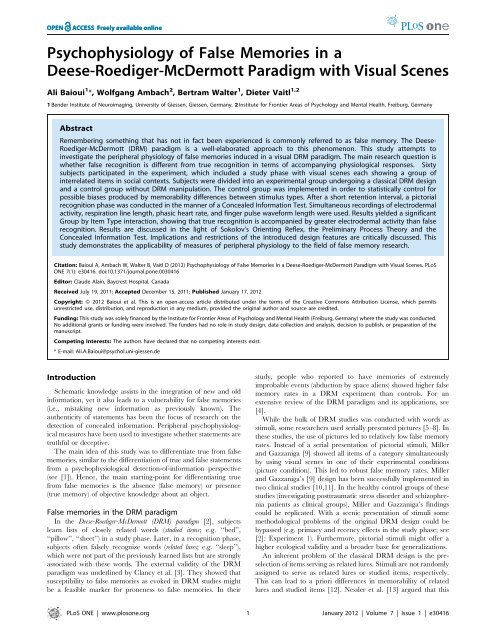
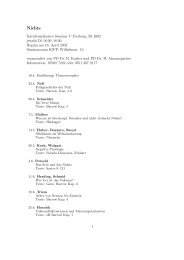
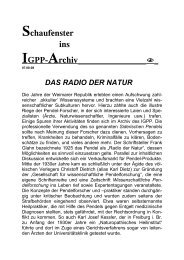
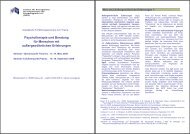
![Findliste Nachträge1 [pdf] - IGPP](https://img.yumpu.com/22552359/1/184x260/findliste-nachtrage1-pdf-igpp.jpg?quality=85)

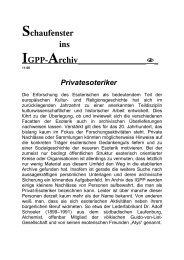
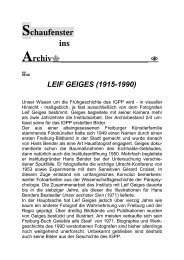
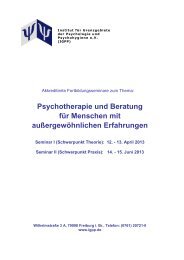
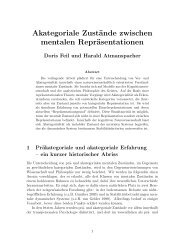
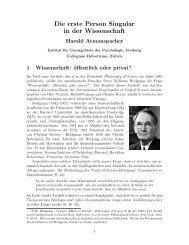
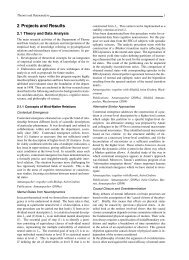
![Findliste [pdf] - IGPP](https://img.yumpu.com/22552265/1/190x245/findliste-pdf-igpp.jpg?quality=85)

